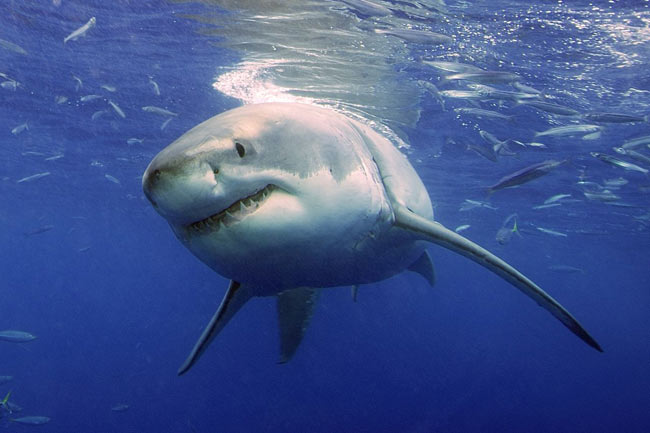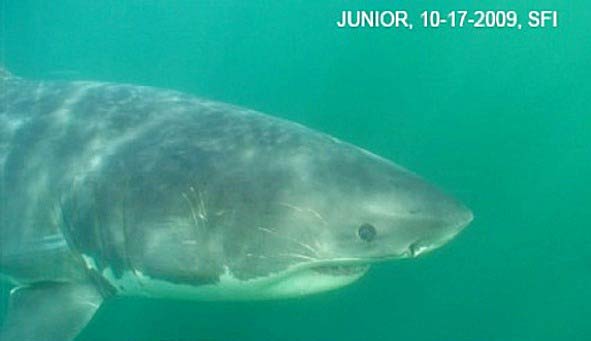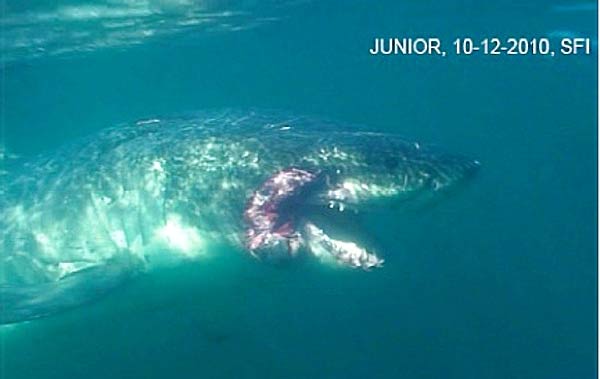Catch & Release: Great White Shark Science Sparks Controversy


Great white sharks, the largest predatory fish in the ocean, are supreme fodder for headlines. Yet in recent weeks, it is the humans who study them that have grabbed the spotlight among a circle of bloggers and advocates for the iconic species.
One scientist and his methodology for studying the sharks have been at the center of the controversy: Michael Domeier, a marine biologist whose quest to study great white sharks and outfit them with satellite tags has been documented over several years and two seasons on the National Geographic Channel's "Shark Men."
Domeier seeks to learn the mysterious migration habits of the sharks, specifically the females. Where they go on their two-year wanderings and where they give birth is a big unknown for researchers — and key information if the species is to be saved, some say. Domeier is the first scientist to attempt to track mature great white sharks with satellite tags that can deliver that information.
Around the world, shark populations suffered precipitous declines in recent years, and although much is unknown about great white sharks' population status, they are considered a vulnerable species.
In order to gather the data he's after, Domeier uses blunted hooks to bring a shark alongside a boat, then lifts the fish out of the water for 15 to 20 minutes. A hose is put in the shark's mouth to allow it to breath, a wet towel is placed over the eyes to calm it, and Domeier gets to work, taking blood samples, checking the sex of the shark, and attaching a satellite tag to the shark's dorsal fin.
Similar protocol is practiced by many groups of shark researchers around the globe, generally on smaller sharks. Yet Domeier's work has provoked strong criticism among some would-be defenders of great white sharks, and in some corners of the blogosphere the conversation has been reduced to accusations, name-calling and ad hominem attacks, first against Domeier and the methods he uses to tag sharks, and now between commenters.
Shocking photos
Get the world’s most fascinating discoveries delivered straight to your inbox.
A picture of a shark with a gruesome injury reignited the controversy several weeks ago. Domeier and his crew tagged the male shark, dubbed Junior, in October 2009. When it was caught, the shark was hooked in the back of the throat — which is unusual. The crew managed to cut off part of the hook, but a portion of it was left in the shark.
In October 2010, an unidentified party took a video of the same shark (visually identified by its markings and the presence of a satellite tag on its dorsal fin) with a gaping wound beside its mouth.
A few weeks ago, many months after the video was taken, a horrifying still from the video was sent around to shark blogs, according to David Shiffman, a marine science grad student and shark researcher who writes about sharks for the blog SouthernFriedScience.
The original source of the image, and why it was sent now, is unclear.
Although there is little to no evidence that the shark's wound is in any way related to Domeier's work, accusations have flown.
Domeier says the full video shows that Junior's head is covered with bite marks, most likely from another great white. The species is known to attack its own.
Despite the lack of evidence to support their claim, critics say the shark is the victim of heedless human action.
Federal authorities and the Gulf of the Farallones National Marine Sanctuary, where Junior was first tagged and the video was taken, are reviewing the case, and say they will issue a report in the coming months, and until then, the video is unavailable to the public.
The scientific community has publicly remained largely silent on the issues of both Junior's injury and Domeier's methods in general. Many scientists are loath to join the fray for professional reasons, and some simply said they couldn't comment.
As to the overarching issue of research practices, some scientists say it's impossible to qualify Domeier's methods in the extreme — as saintly or damnable. There are pros and cons to the hooking and tagging of large great whites, they say, and answers to the question are too nuanced for a two-sided shouting match.
Mysterious and threatened
In spite of their larger-than-life status, much about great white sharks remains mysterious, said Kenneth J. Goldman, a fishery biologist with the Alaska Department of Fish and Game who has studied sharks for more than two decades.
Although there is a fairly developed understanding of great white shark physiology, scientists still don't know how long the fish live, where they go to give birth and how often they do so.
"Some of this we still are guessing. There are certainly a lot of questions," Goldman told OurAmazingPlanet.
Goldman said that answering some of these fundamental questions is important — for the sake of science, certainly, but also because finding out where great white sharks are pupping could help better manage fisheries, and allow greater protections in the spots where great white sharks are giving birth.
Tagging methods
Goldman catches and tags salmon sharks — a species smaller than great whites — and keeps them out of the water for 5 or 6 minutes. He uses satellite tags, but a smaller model that doesn't convey as much information as the tags Domeier uses.
Goldman expressed concern that the large sharks Domeier studies may not be suited to the methodology Domeier uses — he said if the sharks are overstressed, as they might be when fighting back against a hook and line, they may not be able to regulate their body temperature as well, and can suffer as a result. In addition, he worried that perhaps their soft, cartilaginous bodies can't handle the pressure of being on a hard deck for a long period of time, and their organs might be affected.
Domeier said via email that the sharks must be tired out to some extent, otherwise they would be unmanageable on the boat. He said that sharks are more durable than the many other large fish species he's worked with — groupers, marlins, tuna — and "the notion that these large sharks undergo organ crush is based entirely upon speculation. I think our work has demonstrated that it does not occur, and I would not expect it to occur."
However, despite his concerns, Goldman acknowledged that getting the sharks out of the water is the only way to attach the specific type of long-lived tags Domeier uses to track the sharks over a number of years. "Certainly for large-scale movements there's not a tool that's much better," Goldman said.
Goldman said that researchers are hoping a smaller tag capable of delivering the same data will soon be developed, one that can be attached with a long, pole-like device so the sharks can stay in the water.
"Until a time when that or something analogous to it comes out where you'd not have to restrain these fish, that would be one step better," Goldman said, "but in the interim, that's pretty much what has to be done."
Goldman said he had no concerns about Domeier as a scientist, and described him as a respected colleague, yet remained circumspect about his chosen methodology, saying he was neither for it nor against it.
A question of questions
John O'Sullivan, who heads up the white shark program at the Monterey Bay Aquarium in California, said that scientists are in the business of asking questions, and then have to figure out how to go about answering them.
"So your research questions to some extent drive the tools you use," O'Sullivan said.
Domeier explained that he chose his tools to answer a question that, so far, great white shark scientists had been unable to answer — where do the females go? Earlier research showed they disappeared from their feeding grounds around islands for up to two years at a time.
"I felt it was important to determine the entire migration pattern for females in case they were traveling to a part of the ocean where they would be very vulnerable to fisheries," Domeier said.
Although others had undertaken somewhat similar studies in other parts of the world, Domeier was the first to attempt such a project on such large great white sharks.
"The new tags I used required the shark be removed from the water; that decision was not taken lightly," Domeier said. "It took me two years to prepare, time that I used to develop a method that would reduce the risk to the sharks."
O'Sullivan, who tags juvenile great white sharks for his research, but with a different kind of tag technology, said Domeier is trying to answer important questions about great white sharks. However, he said he couldn't offer an opinion on Domeier's chosen methods.
"Michael has a different research program," O'Sullivan said. "I'm interested in it, I talk with him, because I have no doubt I can learn things from him, but I cannot comment. At some point you just have to make a decision — does what he does and the data he gets justify that?"
However, O'Sullivan said, there is no doubt that shark researchers do their utmost to work responsibly — with human safety first, followed closely by animal safety and well-being.
In his three decades of field research, O'Sullivan said, "I have never been exposed to somebody who is irresponsible — and that's a good thing."
Changing tactics
O'Sullivan is part of a group of leading shark researchers from around the globe who are in the process of developing a “best practices” guide for tagging sharks, and said the manuscript is still in the works.
In the meantime, Domeier said he is no longer using the precise tagging technique he used for the NatGeo show.
"Myself and a group of leading shark researchers have voluntarily stopped using such tags because of issues related to fin damage," Domeier said. "Plastic bolts, like I used on 'Shark Men,' permanently affix the tag to the fin and can gradually cause the fin to deform."
An alternative method employs metal bolts designed to rust away over time, but Domeier said such bolts rust unevenly, and can cause major fin damage.
"We've got a plan to fix this, but it is taking longer than anticipated. The sharks can survive with a damaged fin, but it is our responsibility to fix obvious, correctable things that negatively impact the sharks," Domeier said.
Because of his work developing new tagging technology and a current book project, Domeier said he turned down the opportunity to join the next season of "Shark Men."
Although Doemeier said being on television had put pressure on his work — displaying his successes but also his mistakes for all to see — he said that as a scientist, the show offered him a unique opportunity to try to influence public opinion in a positive way.
"Our oceans do not speak, so someone needs to speak for them," Domeier said.
Where's Junior?
So what of Junior, the injured shark whose grisly picture sparked all the recent shouting? The creature has continued to roam, logging some 7,000 miles (11,265 kilometers) since it was tagged in 2009. Its satellite tag last pinged on April 10 in the middle of the Pacific Ocean, between Hawaii and California.
As to Domeier's work, and the outcry it has provoked in some quarters, Goldman said it's important for scientists themselves to stay focused on the research and the data.
"This is not about an individual, it's about a practice, and is it the most appropriate thing to do." Goldman said. "And if it is, we want to do it, but if it's not, we want to step back and think about it."
"There's a lot to take into consideration," he said. "There's a lot of potential danger involved in working on a bouncing boat with big fish."
- In Images: The Fantastic Fishes of Shark Island
- Q&A: 'Shark Men' Get Up Close with Great Whites
- On the Brink: A Gallery of Wild Sharks
Andrea Mustain is a staff writer for OurAmazingPlanet, a sister site to LiveScience. Reach her at amustain@techmedianetwork.com. Follow her on Twitter @AndreaMustain.




